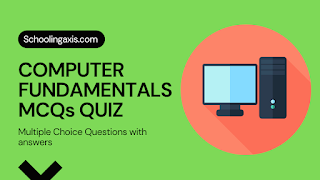1. The word ____________comes from the name of a Persian mathematician Abu Ja’far Mohammed ibn-i Musa al Khowarizmi.
A. Flowchart
B. Flow
C. Algorithm
D. Syntax
Answer = Algorithm
2. In computer science, algorithm refers to a special method usable by a computer for the solution to a problem.
A. True
B. False
C. Nothing Can be said
D. None of the mentioned
Answer = True
3. This characteristic often draws the line between what is feasible and what is impossible.
A. Performance
B. System Evaluation
C. Modularity
D. Reliability
Answer = Performance
4. The time that depends on the input: an already sorted sequence that is easier to sort.
A. Process
B. Evaluation
C. Running
D. Input
Answer = Running
5. Which of the following is incorrect?Algorithms can be represented:.
A. as pseudo codes
B. as syntax
C. as programs
D. as flowcharts
Answer = as syntax
6. When an algorithm is written in the form of a programming language, it becomes a _________.
A. Flowchart
B. Program
C. Pseudo code
D. Syntax
Answer = Program
7. Any algorithm is a program.
A. True
B. False
C. Nothing Can be said
D. None of the mentioned
Answer = False
8. A system wherein items are added from one and removed from the other end.
A. Stack
B. Queue
C. Linked List
D. Array
Answer = Queue
9. Another name for 1-D arrays
A. Linear arrays
B. Lists
C. Horizontal array
D. Vertical array
Answer = Linear arrays
10. A data structure that follows the FIFO principle.
A. Queue
B. LL.
C. Stack
D. Union
Answer = Queue
11. Programming based on stepwise refinement process
A. Structural
B. C programming
C. Procedural
D. Fine
Answer = Structural
12. Top-down approach is followed in structural programming.
A. True
B. False
C. Nothing Can be said
D. None of the mentioned
Answer = True
13. A ________ is a directed graph that describes the flow of execution control of the program.
A. Flowchart
B. Flow graph
C. Complexity curve
D. Algorithm
Answer = Flowchart
14. A program should be ________.
A. Secure
B. Sequential
C. Ordered
D. Simple
Answer = Sequential
15. The following is the syntax for: ____(condition) action
A. Else
B. Elif
C. If
D. Switch
Answer = If
16. Which of the following is a loop statement.
A. IF.
B. ELSE.
C. WHILE.
D. DO.
Answer = WHILE
17. What is the correct syntax of for statement.
A. for(initialization;condition;update).
B. for(initialization,condition,update).
C. for(condition;initialization;update).
D. for(initialization;condition;).
Answer = for(initialization;condition;update)
18. Semicolon is used after :.
A. Function definition
B. Function call
C. for loop
D. while loop
Answer = Function call
19. The number of values a function can return at a time.
A. 1.
B. 0.
C. 2.
D. more than 2.
Answer = 1
20. Which of the following isn’t a loop statement.
A. for
B. elif
C. while
D. do-while
Answer = elif
21. In computer science, algorithm refers to a pictorial representation of a flowchart.
A. True
B. False
C. Nothing Can be said
D. None of the mentioned
Answer = False
22. The process of drawing a flowchart for an algorithm is called __________.
A. Performance
B. Evaluation
C. Algorithmic Representation
D. Flowcharting
Answer = Flowcharting
23. Actual instructions in flowcharting are represented in __________.
A. Circles
B. Boxes
C. Arrows
D. Lines
Answer = Boxes
24. The following box denotes.
A. Decision
B. Initiation
C. Initialization
D. I/O.
Answer = Decision
25. A box that can represent two different conditions
A. Rectangle
B. Diamond
C. Circle
D. Parallelogram
Answer = Diamond
26. There should be certain set standards on the amount of details that should be provided in a flowchart.
A. True
B. False
C. Nothing Can be said
D. None of the mentioned
Answer = False
27. A detailed flowchart is called ______.
A. Stack
B. Macro
C. Micro
D. Union
Answer = Micro
28. Which of the following is not an advantage of a flowchart.
A. Better communication
B. Efficient coding
C. Systematic testing
D. Improper documentation
Answer = Improper documentation
29. A flowchart that outlines the main segments of a program.
A. Queue
B. Macro
C. Micro
D. Union
Answer = Macro
30. Keep the statement language ______________ while writing a pseudo code.
A. Dependent
B. Independent
C. Case sensitive
D. Capitalized
Answer = Independent
31. Capitalize initial keyword – This is a rule while writing a pseudo code.
A. True
B. False
C. Nothing Can be said
D. None of the mentioned
Answer = True
32. Which of the following is not a keyword.
A. Read
B. Write
C. start
D. endif
Answer = start
33. ______________ is used to show hierarchy in a pseudo code.
A. Indentation
B. Curly Braces
C. Round Brackets
D. Semicolon
Answer = Indentation
34. The statement that tells the computer to get a value from an input device and store it in a memory location.
A. read
B. write
C. READ.
D. WRITE.
Answer = READ
35. _____________ are identified by their addresses, we give them names (field names / variable names) using words
A. Memory variables
B. Memory Locations
C. Memory Addresses
D. Data variables
Answer = Memory Locations
36. ____________ begins with lower case letters
A. Keywords
B. Variables
C. Tokens
D. Functions
Answer = Variables
37. Another notation for exponentiation.
A. *.
B. **.
C. ***.
D. *^.
Answer = **
38. A symbol used for grouping.
A. ().
B. {}.
C. []..
D. ” ”.
Answer = ()
39. A statement used to close the IF block.
A. ELSE.
B. ELSEIF.
C. END.
D. ENDIF.
Answer = ENDIF

